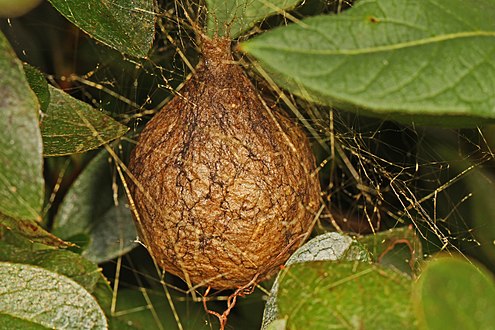Years ago, when the Trucker and I were newly married and in our first home, I was weeding a flowerbed that rimmed the back porch.
And came upon a spider of Great Size. Resting head downward, clinging to a web of Great Size.

Which caused the noises coming out of me to be of Great Size.
The Trucker obligingly dealt with the problem in a way that I didn't even want to know about.
Later research enlightened me to the fact that this was a Yellow Garden Spider.
Wikipedia says this:
It is common to the contiguous United States, Hawaii, southern Canada, Mexico, and Central America. It has distinctive yellow and black markings on the abdomen and a mostly white cephalothorax.
And this:
These spiders may bite if disturbed or harassed, but the venom is seemingly harmless to humans.
And also this:
The web of the yellow garden spider is distinctive: a circular shape up to 2 feet (60 cm) in diameter, with a dense zigzag of silk, known as a stabilimentum, in the center. The purpose of the stabilimentum is disputed. It is possible that it acts as camouflage for the spider lurking in the web's center, but it may also attract insect prey, or even warn birds of the presence of the otherwise difficult-to-see web. Only those spiders that are active during the day construct stabilimenta in their webs.
Today I was weeding a long neglected area and came upon this:
Another yellow garden spider! Yay! This time, I knew better than to disturb or annihilate her. We existed side by side for a time. Me, tugging large weeds from saturated soil, and she, resting head down in the center of her web, waiting.
Her web was all of two feet in diameter on the lilac bush. She knew when the wind was causing it to sway, and when the movement was from a blundering insect that was ensnared by the sticky strands. I was actually tempted to scoot down to the garden, grab a grasshopper, and tangle it in her web, just to see her in action. But I couldn't bring myself to sacrifice a naive little hopper just for my own curiosity.
Back to our first home, where I had destroyed the "original" yellow garden spider.
After I learned what she was, and how beneficial she was, I waited and watched for another. Finally, the wait was rewarded.
The children and I watched her all summer. She grew to immense size, and always kept a tidy, well repaired web. In early fall, she made egg sacs. Five of them. They looked like this:

After making the sacs, she shrank markedly. No wonder! She grew more and more feeble, and finally died.
The egg sacs lived on. All but one, which we carefully cut it open. A difficult job! There were multiple layers, none of which would tear, and some that defied even my sharpest kitchen knife. But at last we found the eggs. Hundreds, maybe thousands of them. So small, almost invisible. It looked like the eggs had been laid on a flat layer, covered several times with a different coating each time, then the layer was rolled into an egg shape, and covered with several more layers. The outer layer look and felt almost like a paper bag, but we could not tear it, and only cut it after tries with several different tools.
The sacs that remained outdoors were buffeted by winter winds and temperatures til spring. One day they seemed covered with a fine dust. In reality, each little grain of "dust" was a spider baby. Next day they were gone; only the open egg sac gave testament to what happened there. Did they crawl away? Did they shoot out a silk balloon and fly away? We don't know.
Some questions remain. Where do they come from? It seems they don't exist in communities, but stake out their own territory. How do they know where to settle? And how does a spider manage to produce all those eggs, and the material to cover and protect them, from her own body? Not only to keep the eggs safe in an impenetrable sac til spring, but also protect from winter temperatures? And how did they know when to hatch? (We had actually taken a second egg sac that long ago year, and kept it in the house all winter. It hatched out the same time as the outdoor sacs, despite being in warm temperatures all winter.)
And why do they, of all arachnids, weave a stabilimentum in their webs? The root word being stable, or stability.
I need a stabilimentum in my own life.
Actually, I have one. Thank you Lord, for your presence and your Word. And the marvelous world that surrounds us. Including the Yellow Garden Spider.

No comments:
Post a Comment